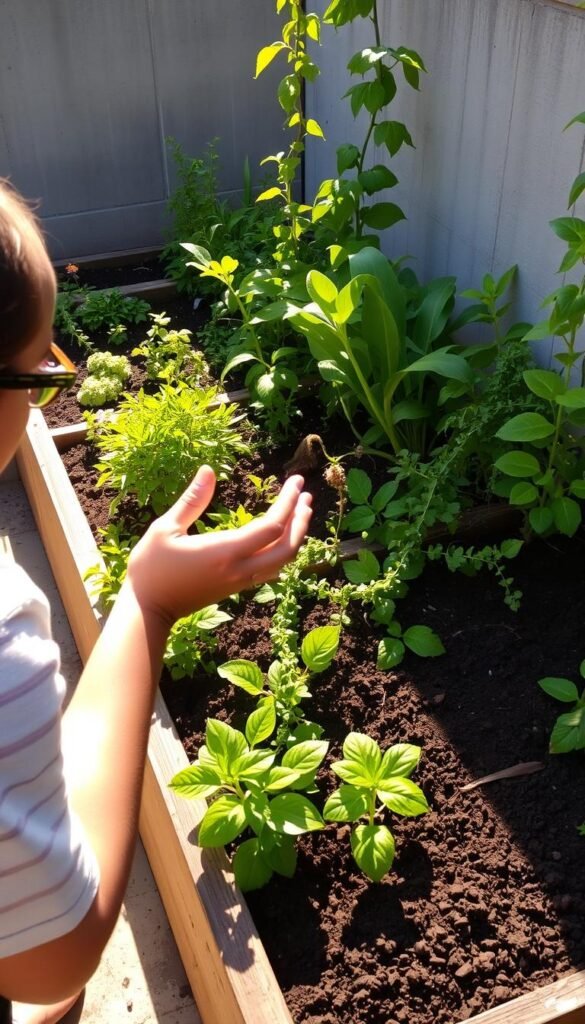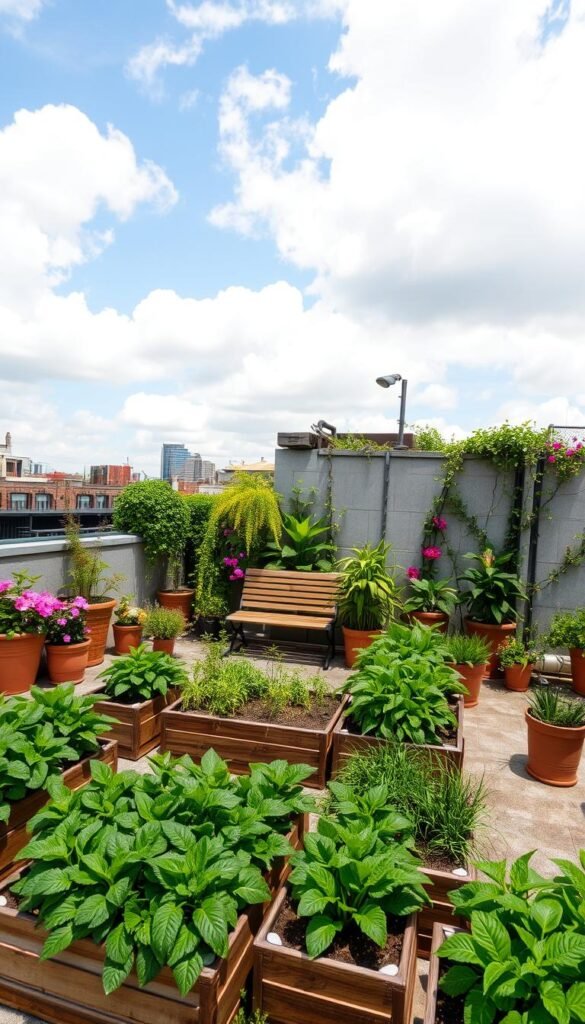Imagine stepping outside to a lush retreat in the heart of the city. With a little creativity, even the smallest balcony or windowsill can burst with life. This practice isn’t just about adding plants—it’s about reclaiming overlooked spaces to grow fresh herbs, vegetables, or flowers. Think rooftop gardens in Brooklyn or community plots in Chicago: these projects prove that any area can thrive with greenery.
Why does this matter? Cities often lack green zones, but growing your own food or flowers boosts mental health and reduces your carbon footprint. Plus, you’ll enjoy organic produce without relying on store-bought options. Whether you’re nurturing basil in a repurposed crate or joining a shared garden, the benefits ripple through your home and neighborhood.
You don’t need a backyard to start. Simple tools like containers, vertical planters, or raised beds make it easy. Beginners can try hardy herbs like mint or rosemary, while seasoned growers might experiment with tomatoes or peppers. This guide will walk you through budget-friendly tips and smart strategies, no matter your experience level.
Ready to turn that concrete corner into a vibrant sanctuary? Let’s dig into the essentials—from choosing the right soil to fostering community connections. Your urban oasis is closer than you think.
Understanding the Importance of Urban Gardening

What began as wartime victory gardens now fuels modern environmental movements. Today’s version blends creativity with sustainability, turning underused areas into thriving ecosystems. This practice has grown from small backyard plots to rooftop farms and shared neighborhood spaces—all while addressing pressing city challenges.
Defining Urban Gardening and Its Evolution
Urban gardening means growing plants in city environments, using balconies, rooftops, or abandoned lots. It gained traction during the 1940s when families grew food to support war efforts. Now, it’s evolved with hydroponic systems and vertical designs that maximize limited space.
Environmental and Social Benefits for City Dwellers
These green spaces cool neighborhoods by up to 10°F, fighting the “heat island” effect caused by concrete. They also filter pollutants—one mature tree can absorb 48 pounds of carbon dioxide yearly. Beyond cleaner air, gardens create gathering spots where neighbors share harvests and skills.
| Benefit | Environmental Impact | Social Impact |
|---|---|---|
| Air Quality | Reduces CO2 by 15-20% locally | Lowers respiratory issues |
| Heat Reduction | Cools surfaces by 20-45°F | Makes outdoor areas usable |
| Community | Supports pollinators | Builds teamwork & food security |
In Detroit, over 1,400 community gardens provide fresh produce in food deserts. Phoenix residents use shade-loving succulents to beautify sun-baked alleys. Whether you’re growing herbs or flowers, every plant strengthens your connection to the environment and those around you.
Assessing Your Available Space and Sunlight

Unlocking your space’s green potential starts with understanding two critical factors: light patterns and layout. Before buying seeds or pots, grab a notebook and track how sunlight moves through your area over 2-3 days. This simple step reveals where plants will thrive—and where they’ll struggle.
Evaluating Sunlight, Shade, and Microclimates
Start by checking light exposure every two hours. Full-sun spots get 6+ hours of direct rays—ideal for tomatoes or peppers. Partial shade areas receive 3-6 hours, perfect for leafy greens. Watch for microclimates caused by walls or pavement that trap heat or block light.
South-facing balconies often get the most sun, while north-facing ones stay cooler. Use free apps like Sun Seeker to map solar paths. Remember: buildings cast longer shadows in winter, changing your light availability.
Identifying Ideal Spots in Your Urban Environment
Measure your available areas with a tape measure. Even a 2’x4’ windowsill can host herbs in tiered planters. Consider these options:
- Rooftops: Great for sun-loving plants but check weight limits
- Fire escapes: Use hanging baskets (verify local regulations)
- Alley corners: Try shade-tolerant ferns or mint
Quality matters most in tight spaces. Choose dwarf varieties bred for containers, and prioritize plants matching your climate zone. Your experience grows with each season—start small, observe results, and expand gradually.
Choosing the Best Plants for Your Urban Garden

Your plant choices shape your garden’s success and enjoyment. Whether you prioritize fresh produce or vibrant blooms, smart selections maximize limited space while minimizing effort. Let’s explore how to balance practicality and beauty in your green haven.
Edible vs. Ornamental Plant Selections
Edible options like cherry tomatoes or basil let you harvest meals steps from your kitchen. These vegetables and herbs typically need 6+ hours of sunlight but reward you with fresh flavors. Ornamental varieties like lavender or marigolds add color while attracting pollinators.
Many best plants for urban gardens serve dual purposes. Swiss chard’s rainbow stems brighten spaces, while rosemary offers fragrant foliage. Mix edible and decorative species for a garden that feeds both body and soul.
Low-Maintenance Varieties for Busy Lifestyles
Choose perennials like mint or thyme that return yearly with minimal care. Snake plants and ZZ plants thrive in low light with sporadic watering—perfect for hectic schedules. Dwarf fruit trees in containers yield produce without demanding much space.
Simplify maintenance with these tips:
- Use self-watering pots for consistent moisture
- Apply mulch to reduce weeding
- Group plants with similar sunlight needs
By matching your selections to your routine and environment, you’ll create a thriving green space that fits seamlessly into city life.
Container Gardening and Vertical Solutions for Limited Spaces

Who says small spaces can’t host vibrant gardens? With clever container setups and vertical designs, even cramped corners burst with life. These approaches let you adapt to changing light and maximize every inch, turning walls and railings into lush displays.
Benefits of Flexible Container Gardening
Containers let you grow herbs, flowers, or veggies anywhere—no permanent beds needed. Move pots to chase sunlight or shield plants from harsh weather. Lightweight options like fabric grow bags or repurposed crates work well for renters. Try stacking planters on shelves or hanging them from ceilings to multiply your growing area.
Creative Ideas for Vertical Green Walls and Trellises
Turn blank walls into living art with pocket planters or modular panels. Train climbing plants like beans or ivy on trellises made from bamboo or recycled lattice. For quick results, use pre-grown succulent frames that thrive with minimal care. These systems add visual depth while keeping floors clear.
| Vertical System | Best Plants | Space Saved |
|---|---|---|
| Wall Pockets | Strawberries, herbs | Up to 80% |
| Tiered Towers | Lettuce, flowers | 65-70% |
| Hanging Baskets | Cherry tomatoes, trailing vines | 90%+ |
Start with one vertical structure or a few portable containers. Rotate plants seasonally to keep your oasis fresh year-round. Even a fire escape can become a cascading garden with the right techniques.
Optimizing Soil, Water, and Fertilization Techniques

Healthy plants start from the ground up—literally. Your garden’s success hinges on three pillars: nutrient-rich soil, smart watering, and balanced feeding. These elements work together to create a thriving environment, whether you’re growing herbs on a fire escape or tomatoes in raised beds.
Building Strong Foundations with Better Soil
City soil often lacks organic matter. Mix equal parts compost, peat moss, and perlite for containers—this combo retains moisture while letting roots breathe. For raised beds, add coarse sand to improve drainage. Test your soil’s pH yearly; most veggies prefer 6.0-7.0.
Prevent waterlogging by drilling extra holes in pots or layering gravel beneath soil. Community gardens often use French drain systems—perforated pipes buried under beds—to redirect excess water. These simple fixes protect roots from rot during heavy rains.
Water Wisely, Feed Naturally
Morning watering reduces evaporation. Use a drip system or self-watering pots to deliver moisture directly to roots. Collect rainwater in barrels—it’s free of chlorine and better for delicate plants.
Organic fertilizers like fish emulsion or compost tea feed plants slowly without chemical burns. One gardener in Seattle boosted her kale yield by 40% using worm castings. Apply fertilizers every 4-6 weeks during growing seasons for steady growth.
| Soil Amendment | Benefit | Best For |
|---|---|---|
| Compost | Adds nutrients | All container plants |
| Perlite | Improves airflow | Seed starters |
| Biochar | Retains moisture | Raised beds |
Remember: healthy soil means less work later. Pair these techniques with regular checks—stick your finger 2” deep to gauge moisture. Your plants will reward you with vibrant leaves and plentiful harvests.
Essential Tools and Maintenance Strategies for Urban Gardens
The right gear turns cramped corners into flourishing ecosystems. City growers need equipment that fits tight spaces while standing up to daily use. Start with these essentials to keep your green haven thriving.
Must-Have Gardening Tools for City Spaces
Invest in a compact toolkit that handles multiple tasks. A foldable hand trowel, precision pruners, and collapsible watering can save precious storage space. Durable gloves protect your hands when working with rough containers or trellises.
Weekly checks prevent big problems. Inspect leaves for discoloration or holes—early pest detection stops infestations. Use a magnifying glass to spot aphids or mites hiding under foliage.
- Store tools vertically on wall hooks to free floor space
- Disinfect pruners with rubbing alcohol after each use
- Try smartphone apps that remind you when to water or fertilize
Busy schedules? Spend 10 minutes daily removing dead leaves and checking soil moisture. Dedicate one weekend morning monthly for deeper tasks like rotating plants or refreshing mulch. Consistent care builds healthier plants that resist diseases naturally.
Proper tools make maintenance effortless. Self-watering pots with built-in reservoirs support plants during heatwaves. A lightweight soil tester helps you adjust pH without lab trips. When you equip yourself smartly, your green space becomes a joy—not a chore.
A Step-by-Step How-To Guide for DIY Urban Gardening
Let’s walk through building your urban garden from scratch. Start by sketching your space on graph paper—mark windows, walls, and permanent fixtures. This blueprint helps visualize where containers, vertical planters, or hanging baskets will shine. Remember: flexibility is key in small areas.
Planning Your Layout and Garden Design
Map sunlight patterns using free apps like Sun Surveyor. Assign zones:
- Full sun spots: Reserve for tomatoes or peppers
- Partial shade: Perfect for leafy greens like spinach
- Vertical spaces: Install trellises for climbing beans
Choose containers with drainage holes—plastic buckets or fabric grow bags work well. Group plants by water needs to simplify care. A Chicago gardener doubled her harvest by arranging pots in tiered stands near south-facing windows.
Implementing Techniques for Planting and Growth
Mix 2 parts potting soil with 1 part compost for nutrient-rich beds. Follow these steps:
- Soak seeds overnight to speed germination
- Plant herbs like basil ¼” deep, tomatoes ½” deeper
- Space dwarf varieties 6-8” apart in window boxes
Try companion planting: marigolds repel pests near veggies, while mint deters rodents. Water roots directly using a long-spout can to avoid leaf rot. One Brooklyn rooftop garden uses drip systems on timers for consistent moisture.
| Container Type | Best Plants | Maintenance Level |
|---|---|---|
| Fabric Pots | Carrots, radishes | Low |
| Wall Planters | Strawberries, succulents | Medium |
| Self-Watering Boxes | Lettuce, kale | High |
Rotate crops every season to keep soil healthy. With these strategies, your garden becomes a living pantry and sanctuary—no backyard required.
Exploring Innovative Techniques in Urban Agriculture
City growers are embracing high-tech solutions to overcome space constraints. Systems once reserved for commercial farms now fit in apartments, offering soil-free alternatives that yield impressive results. These methods blend science with sustainability, letting you grow more with less effort.
Integrating Hydroponic and Aquaponic Systems
Hydroponics nurtures plants in nutrient-rich water, skipping soil entirely. Aquaponics takes it further by adding fish—their waste feeds the plants, while roots filter the water. A Brooklyn startup reported 30% faster growth for basil using these setups compared to traditional pots.
Why consider these systems? They use 90% less water than soil gardening and eliminate weeds. Sensors can track pH levels and nutrient balance, sending alerts to your phone. One Denver community garden cut pest issues by 60% after switching to enclosed hydroponic towers.
Start small with a countertop herb kit or a desktop aquaponic tank. Many kits include LED grow lights for spaces with limited sunlight. As you gain experience, scale up to vertical wall units that produce leafy greens year-round.
| System | Best For | Space Needed |
|---|---|---|
| Hydroponics | Lettuce, herbs | 2 sq ft |
| Aquaponics | Basil, tilapia | 4 sq ft |
| Aeroponics | Tomatoes, peppers | 3 sq ft |
These approaches let you grow vegetables in closets or under stairs—anywhere with power and creativity. Join online forums to swap tips with others mastering these methods. Your garden could soon rival a farmers’ market!
Urban Gardening 101: Transforming Concrete Spaces into Green Oases
From abandoned railways to forgotten rooftops, creative gardeners prove every inch holds potential. Let’s explore how ordinary spaces became extraordinary green hubs—and how you can replicate their success.
Urban Innovation in Action
New York’s High Line transformed a rusty rail track into a 1.5-mile elevated park bursting with native grasses and perennials. This garden now cools surrounding buildings while attracting 8 million visitors yearly. Chicago City Hall’s rooftop oasis reduces stormwater runoff by 75% using drought-resistant sedums.
“Start with one container. Watch how it changes your view of the city.”
Proven Strategies for Your Space
Experts recommend these tactics for thriving urban spaces:
- Use reflective surfaces near balconies to boost sunlight for herbs
- Pair shallow-rooted vegetables like lettuce with deep planters
- Install drip systems on timers for consistent watering
| Project | Key Feature | Community Impact |
|---|---|---|
| Detroit’s RecoveryPark | Aquaponic greenhouses | Creates 80+ local jobs |
| LA’s TreePeople | Shade trees + food forests | Cools streets by 10°F |
| Seattle P-Patches | Shared vegetable plots | Feeds 10,000+ annually |
These examples show how gardening revitalizes both areas and attitudes. Whether you’re growing herbs or hosting neighborhood workshops, your efforts create ripples of change. Ready to write your own success story?
Embracing a Greener Future in Your Urban Space
Your journey toward a sustainable cityscape starts with a single potted plant. Through container gardens on balconies or hydroponic setups in apartments, you’ve seen how urban gardens cool neighborhoods, purify air, and strengthen communities. These spaces prove that even compact areas can yield fresh food and vibrant blooms.
Remember the success stories: rooftop farms feeding thousands, vertical walls reducing heat islands. Whether you’re planting herbs in repurposed containers or joining a shared plot, your efforts matter. Modern tools—from self-watering systems to soil sensors—make gardening accessible regardless of experience.
Now imagine your city transformed—every windowsill bursting with life, every alley humming with pollinators. This future thrives on collaboration. Swap seeds with neighbors, attend workshops, or advocate for green policies. Each action ripples outward, creating healthier ecosystems and tighter-knit blocks.
Ready to grow? Start small, experiment often, and share your wins. Every gardener adds another leaf to this living movement. Your concrete jungle could blossom into an oasis—one space, one season, at a time.






